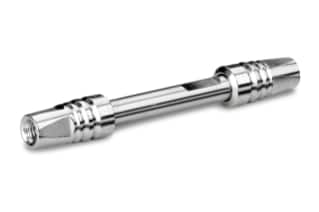
|
Chemistry |
C18 |
|
Separation Mode |
Reversed Phase |
|
Particle Substrate |
Hybrid |
|
pH Range Min |
1 pH |
|
pH Range Max |
12 pH |
|
Endcapped |
Yes |
|
Silanol Activity |
Low |
|
Molecular Weight Range Min |
1000 |
|
Molecular Weight Range Max |
15000 |
|
Particle Shape |
Spherical |
|
Particle Size |
1.7 µm |
|
Endfitting Type |
Parker-style |
|
Pore Size |
130 Å |
|
QC Tested |
Peptide |
|
Format |
Column |
|
Surface Area |
185 |
|
System |
UPLC, UHPLC |
|
Particle Technology |
BEH |
|
USP Classification |
L1 |
|
Inner Diameter |
2.1 mm |
|
Length |
50 mm |
|
Carbon Load |
18 % |
|
UNSPSC |
41115709 |
|
Application |
Peptide |
|
Brand |
ACQUITY UPLC |
|
Product Type |
Columns |
|
Units per Package |
1 pk |

ACQUITY UPLC Peptide BEH C18 Column, 130Å, 1.7 µm, 2.1 mm X 50 mm, 1K - 15K, 1/pk
Based on Waters’ BEH particle and C18 bonding technology, ACQUITY UPLC Peptide BEH C18 Columns are optimized and QC tested for stable and reproducible peptide separations based on Waters Peptide Separation Technology. These unique columns meet the demanding requirements of peptide separations, offering improved chromatography of peptides through narrow, symmetrical peaks for the best possible resolution. This technology enables successful separations of a wide range of peptides, large and small, acidic and basic, hydrophobic and hydrophilic, with good peak shape and retention. Combined with the benefits of a sub-2 µm particle, this unique column chemistry leads to the ultimate resolution.
The small-pore, trifunctionally bonded BEH particle used in ACQUITY UPLC Peptide BEH C18 Columns offers the widest usable pH range, superior stability at a low pH, and ultra-low column bleed to assay samples for proteomics, protein characterization, and peptide synthesis.
In addition to meeting the standards for BEH particles, ACQUITY UPLC Peptide BEH C18 Columns are specifically QC certified with a peptide map. These controls ensure the stability of well-developed peptide separations in addition to predictable behavior across varying samples. The Peptide Separation Technology used provides a consistent set of chromatographic tools and lab equipment, usable across all research and development applications that require analysis or isolation of peptides.
Columns are sold individually and can be purchased along with accessories like the ACQUITY UPLC BEH C18 VanGuard Pre-column, 130Å, 1.7 mm, 2.1 mm X 5 mm, 3/pk to extend column lifetime. The column has an inner diameter of 2.1 mm and a length of 50 mm.
How Do I Equilibrate ACQUITY UPLC Peptide BEH C18 Columns?
Columns are shipped in 100% acetonitrile. Before changing to a different mobile phase system, it is important to ensure mobile phase compatibility. Columns can be equilibrated using a minimum of 10 column volumes of the mobile phase to be used. In a 2.1 mm X 50 mm column, this is 0.2 mL. In order to avoid precipitating mobile phase buffers on your column or in your system, flush the column with five column volumes of water/organic solvent mixture, using the same or lower solvent content as in the desired buffered mobile phase.